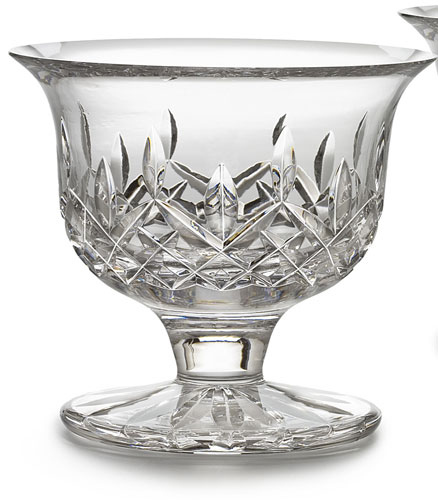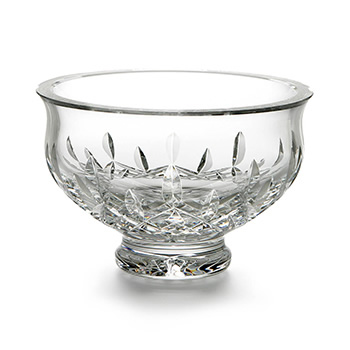Overview:
The manufacturing of glass is an art and process established over 2000 years ago and uniquely has changed very little apart from the addition of lead to create today’s lead crystal. Lead crystal usually comprises of 48% silica sand, 24% potash and 28% red lead. The mix creates an optimum balance of clarity, weight and hardness. With its complicate manufacturing process and exceptionally high perceived value, the lead crystal has been sought after and treasured for generations, and remains a status symbol even today.
The lead crystal formula is mixed and turning into molten crystal in a furnace heated over 2000F. Red lead is added into the furnace to create the purity and density.
Lead crystal is blown glass but because of its weight and thickness it requires a coordinated team of blowers. They use their skill and experience to create the glass body to the correct thickness. This is necessary to enable the glass designs to be deep cut. At this time other parts such as handles can be added.
The pieces are then placed in an annealing oven – under controlled conditions the oven slowly and evenly heats the glass to an annealing temperature. After a brief soaking period to ensure even heat distribution throughout the glassware, the oven temperature is slowly returned to room temperature.
The lead crystal glass is now ready to be cut. A pattern is drawn on the items and then mapped out with a power wheel. The finished design is then completed using diamond tip wheels using a combination of flat and wedge cuts to provide contrast, followed by the smoothing process on a sandstone wheel.
To finish the items it is dipped into a combination of sulphuric and hydrofluoric acid which removes a thin layer of glass providing a uniform and luster finish.
History of Lead Crystal:
Like many cultural advances the history of glass and crystal began with the Roman occupation of Britain and eventually reached a high point in the stained glass windows of the middle ages. In the 1500s new skills were added when highly skilled glassblowers moved to London from Venice and attracted royal patronage from Queen Elizabeth.
In the mid 1700s George Ravenscroft started his own glass business in London and patented the formula for producing lead crystal. He found that adding lead to glass during the melting process improved the quality. During this period the art of creating patterns by cutting became established and lead crystal was a perfect medium for the art. Many businesses perfected the process and lead crystal and glass became popular creating an established industry. However in the time honored process of all governments they recognized an opportunity for raising taxes and stunted growth and created many closures in the lead crystal sector.
English manufacturers moves their factories to Ireland to avoid taxation and during the period Ireland became the center of lead crystal manufacture, especially in Waterford, where the famous Waterford glass factory was developed in the 18th century. Unfortunately the Irish tax authorities saw an opportunity to raise taxes and forced many of the companies out of business. Waterfords for example did not start trading again until after World War 2. In the meantime during the 19th century other companies in France, Sweden, Italy (Venice), and Sweden were establishing their reputations and creating famous brands such as Orrefors, Baccarat and Swarovski.
Most fine crystal contains lead oxide. 24% is the optimum percentage for color, weight and hardness, while still ensuring clarity, sparkle and brilliance. 24% Lead Crystal, with its exceptionally high perceived value, has been sought after and treasured for generations, and remains a status symbol even today.
Sample Lead Crystal:


